
15 Years of Cables 'n Knobs
Posted By: Shagz
Date:
This is an article I've been meaning to write for years now, since at least 2006, but I just never got around to it. Well today I decided to get around to it. Join me as I walk back through the years and look at all of the different incarnations my dj gear has taken...
This is an article I've been meaning to write for years now, since at least 2006, but I just never got around to it. Well today I decided to get around to it. Join me as I walk back through the years and look at all of the different incarnations my dj gear has taken...
In the Beginning there was Vinyl
Gear: 2x Technics 1200s, Pioneer DJM-500, Tascam CD-DJ
I built up my dj gear over a few years, buying my turntables over two summers. My first mixer was a Gemini, cheap and servicable, with some toys (an 8-second sampler!) but certainly not a professional piece of kit.
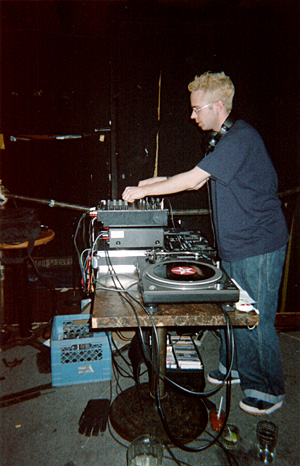
My "tower of power" dj set up, spinning at Ted's Wrecking Yard in 2001.
The Tech 12s...well, what can I say? I've had them '96/'97, and they still work as good today as the day I bought them. They're built like tanks and have been the defacto piece of kit in any club sound system in the world, from the dingy little dive bar to the uber clubs of Ibiza. Their future is far more clouded and shakier than it has ever been in the past, but no one can question their legendary influence and Hall of Fame status.
The Tascam....meh. I bought this unit 'cuz it had an interface I was familiar with, and it advertised that you could stratch with it using the jog wheels. Ha! Not really. It sounded more like you were scrubbing digital audio than doing any kind of actual scratching, and it was terribly inaccurate. It had a key lock functionality, but that was only so-so; as soon as you got +/- 2%, audio artifacting started to show up. But, it did the job.
The Pioneer DJM-500 Mixer...a mixer is pretty much the "brain" of any dj set up and it's where you spend most of your time. A mixer is not a complex piece of machinery, but the interface has got to be clear, especially once you start adding bells and whistles.
The Pioneer was a dream to perform with. Indeed, I would say that the Pioneer is up there with the Technics 1200 as far as Hall of Fame status goes. Sasha, Digweed, Paul van Dyck all swore by and requested this mixer for their gigs and with good reason. With big fat knobs and faders, it was simply fun to use and very comfortable. The fader curves were a dream; this was definitely a mixer built for clubbing, not turntablism, and making smooth mixes was really easy.
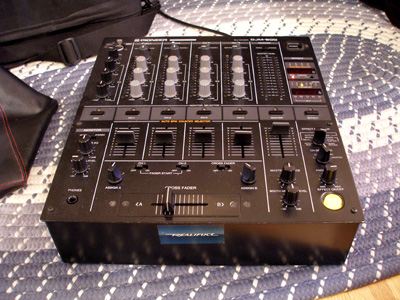
The Pioneer DJM-500, with the big orange button.
The DJM didn't have a lot of effects, but the ones it had sounded great. I mostly played with the Flanger (a staple effect for trance djs), Reverb, Echo (fun tip: tweaking it up into short ranges made everything sound metallic and robotic) and Delay. (I loved using this at a 3/4 beat setting; it would add neat little skitter drum fills to normally straight-forward 4/4 beats) The only thing it was really missing was a Filter, and this would be added in the DJM-600 which came out a few years later.
The Pioneer's effects are all over my early mixes and I used this mixer for pretty much 1/2 my career. I love it to bits, and while I haven't used it in years, I haven't sold it yet. (though that day might be coming soon, a casualty in my attempts to slim down my posessions)
Decks 'n EFX: The Korg KAOS Pad
Gear: Everything above + Korg KAOS Pad KP1
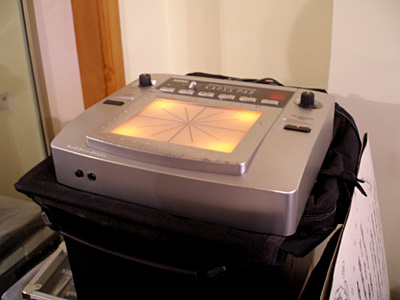
Korg KAOS Pad KP1 just begs to be touched.
For those who don't know, the KAOS pad has touch interface that represents an X/Y Axis. Using the touchpad and moving your finger around, you can control the parameters of two effects at once. Byron used this device a lot in his shows with King Brand Valium, and I fell in love with it when I first saw it, as do most people. The device just gives immediate satisfaction: touch it and crazy stuff starts happening to your sound.
I mainly used the Korg for its High Pass and Low Pass Filters (a staple effect for house djs, or really any electronic music actually), as well as the touch-based sampler. Later on, I'd start using it's massive dub echo chamber as well for doing certain kinds of transitions between tracks.
I don't use the Kaos Pad as much these days, but it's still a lot of fun to bring out, and the audience is always inquisitive when they see it.
A Diversion: Numark Axis 8
Gear: Replaced the Tascam with 2x Numark Axis 8s

My pair of Numark Axis 8s
The Digital Revolution: Serato
Gear: 2x Technics 1200s, Rane TTM-57SL, Serato Scratch Live, Macbook
By 2006, I was starting to finally accept that lugging around several dozens of pounds of vinyl and CDs and road cases didn't make much sense, especially since the digital world provided all the same functionality but in a far smaller footprint and with additional advancements. I was beginning to have back problems, I didn't want to buy a car (or a van!) and cab rides were expensive and ate into whatever money I was making.
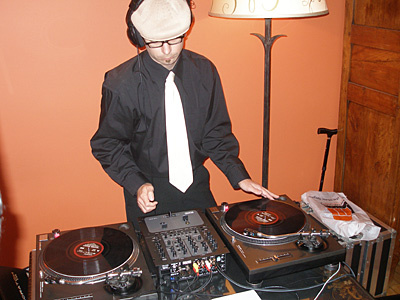
Using Serato at a fashion show in 2007
DIGRESSION: Digital scratching was a problem that the industry had been trying to solve for years and years. Many manufactures attempted to build CD-DJ players that came close (but not quite close enough) to reproducing the feel of scratching a record, and Vestax even came up with a system that used a light and mini-camera to watch the speed and direction of the dots on the side of a turntable platter, and use that information to manipulate a digital file. However, it was the time-code approach that proved to be the most ingenious and most elegant system, combining the best of both digital and analog worlds.
You can read more about DVS here, but the upshot is that you scratch scratch and manipulate mp3 audio just like regular vinyl audio. END DIGRESSION
DVSs had been around for a while, starting with Final Scratch in 2001, but the word in 2006 was that the software for Final Scratch/Traktor was buggy, driver support was terrible and stability was shakey. (In 2011, it's a much different story and Native Instruments, who know owns and maintains Traktor, has made great strides to improving the software) I ended up going to Scratch Live from Serato. The software had a very readable and intuitive interface, was known for its rock solid stability and low-performance requirements, and I had seen plenty of djs around town and internationally using it.
Serato Scratch Live was a revelation.
My main reason for picking it up was that I was finally learning how to scratch, thanks to Erik Laar at the Off Centre DJ School, but being anal about my stuff, I didn't want to scratch up my actual records, so Serato was perfect. This turned out to be only a minor feature that I would use, once I started getting into it.
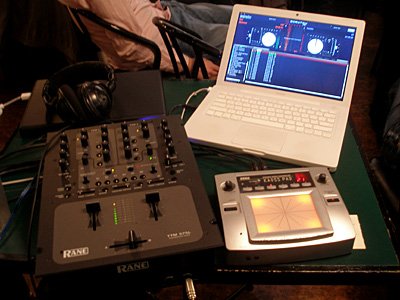
Using just the Rane mixer, my Macbook and my Kaos Pad for a small gig inside a cafe.
The software also made it way easier to set up cue points and create loops, something which I could always have done in the past with my CD players, but never really bothered with.
However, the most eye-opening feature was being able to carry my entire CD collection under my arm. This was such a freeing feeling, creatively speaking. Having nearly every single song I had ever purchased available to me at a moment's notice, tagged with genres and notes to myself, all with the BPMs already determined, all of it easily searchable, made it very easy to react to the vibe of the dance and move the dance floor in the direction I wanted or felt it needed to go.
As a dj, you're often doing a rough plan of your set the night before a gig, going through your recent purchases, your classic stand bys, and figuring out what tracks should be played early on, in the middle and at the end of your set. Once you're at the gig, you can only play what you brought with you. But with a digital system, you can play anthing you own, so if you see somebody go crazy for a particular track, you can quickly look up something else that you know they're going to dig, something which you might not have packed in your bag under the old system.
Like I said, this gave me a real sense of freedom, and a sense of confidence, that no matter what happened on the dance floor, I would always be free to "throw away the script" as it were and play a set custom suited to the people who were there for a good time.
Later on I would get into Serato's built in software effects and hardware controls (The TTM-57SL has the Serato hardware built into its chassis, so you can use buttons on the mixer to control Scratch Live), but that was the #1 "killer feature" for me.
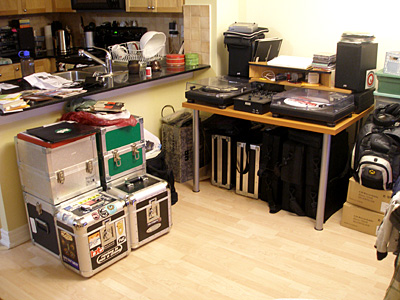
My old set up, using an Ikea table and some planks of wood.
My only major complaint wit the mixer is the upfader curve. It's very linear, so if you're using the upfaders to mix, you have to almost put them at the top before you actualy hear anything of the next track coming in over the old track. Obviously not a deal breaker, and it's something I've learned to work around, but still something to note.
The Present: Out of Control
Gear: Rane TTM-57SL, Serato Scratch, Macbook, Crane Laptop Stand, Native Instruments Kontrol X1, DJay for iOS
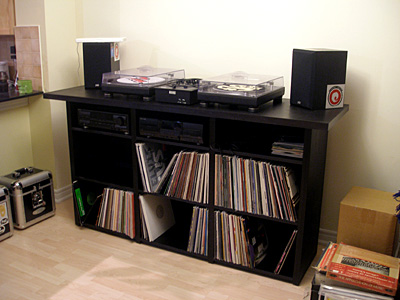
My new set up after I got my custom dj table made.
All the same, you never know what's going to happen, so it's best to be prepared. :) I had been looking into DJ apps for iOS, and had settled on DJay as a solid entry. It has iTunes library integration so it can actually play back tracks that are on your device. (previous "dj" apps could only play back existing, canned loops and tracks) It has all the basics (pitch control, nudging, cue points, cross fader, headphone cue) plus a few bells (auto-loop and auto-loop rolls, mini EQ) all packed into a very clean interface on a very tiny screen.
The cue functionality, for me, is pretty essential if you're going to dj, and their method of working around the iPod/iPhones hardware limitations worked just fine for me. (They use he normal headphone jack, but slit it so the left channel goes to "the floor" and the right is your monitor; perfect!)
As a backup device in case your main kit fails, or if you're suddenly asked to rock a party, DJay will do the trick without much fuss.
And indeed, I got to rock the party! :) The choir peeps are such a responsive, "up for it" bunch of people, so it was a great joy to drop a mini-set for them, and DJay worked quite adequately in this capacity. I was very, very impressed. The only issue I had was accidentally touching some parts of the interface with my "fat" fingers, but nothing you can't work around with a little extra care.
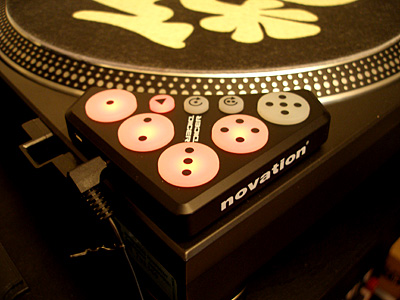
The Novation Dicer: controllerism for the turntablist.
My other recent purchase has been the Native Instruments Kontrol X1. It's built and optimized for use with Traktor, but it can also operate as a stand alone MIDI controller for Serato. With the Kontrol X1, I finally have some hardware controls for mucking around with Serato's software-based effects, as well as using all of its other standard features.
To some extent, the TTM-57SL could do all this, but it couldn't be used for the software-effects as it had its own hardware-based effects, and its interface was a bit "overloaded", with buttons doing up to 6 different things, depending on which controls you had loaded up. The Kontrol X1 is much more straight-forward and is more clearly indicative of what's currently going on, with it's nice, brightly backlit buttons.

The Native Instruments Kontrol X1
With the Kontrol X1, this probably marks the end of my vinyl use. I still buy the occasional vinyl record, but I immediately record and digitize it into an mp3. I'll probably still use the records if I want to do a dj mix with some scraching, but for the kinds of gigs I'm doing these days, it'll just be easier to leave the decks at home.
Not Afraid of the Future
Gear: ???
The future of digital djing is definitely in Controllerism, for better or for worse. (Better: get crazy with the cheese whiz. Worse: Attention Deficiet DJing) And that future probably involves touch screen interfaces of some kind, although not entirely.
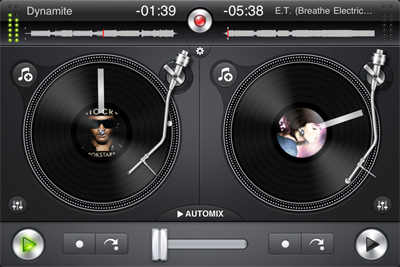
The DJay interface
Some things I'll be keeping my eye on will be touch-based systems like Emulator and future versions of (and competitors to) DJay being used on iPads. There's always Abelton, and maybe Traktor (the amount of control and automation you can do to the effects through midi-controllers in Traktor is quite astounding and open things up to some interesting performance implications)
Elsewhere, I've been making my own dj edits this past year or so, taking the tracks I like and cutting out the annoying parts, or restructuring their arrangements to change how the tracks build and play out. These days there are too many producers making ridiculously long, self-indulgent breakdowns, or worse, putting more than 1 in a track! So I've been getting rid of that stuff to make the tracks more friendly for the kind of sets and venues I play.
DJ software like The One show off some really awesome functionality that could help me in this regard, allowing for easy edits. Right now I'm using a really old copy of SoundForge (4.5!!) so being able to do multi-track edits will be a Godsend. :)
I don't know exactly what the future holds for me, but I will definitely be watching it with great interest!
Hope you enjoyed this post, it took me awhile to piece it together, but it was fun to dig up all those old photos and look back over my career. :)
Your Comments
Post a comment
All fields marked with * are required. Allowable HTML includes <b></b>, <i></i>, <u></u> and <a href="your link">your text</a>. You can type in the HTML by hand or use the formatting buttons below by clicking one and entering in the blanks.
![]()

News | Broadcasts | DJ Mixes | About | Contact | Links
© Copyright 1996-2025 DJ Shagz.com
American Motors Car Photos courtesty of Arctic Boy
 |
Posted by: J Puddy on Great post! Really cool to take a trip through our past. Mine was fairly similar, but much shorter and more rapid! Haha. Glad you like the X1! I've been toying with the idea of getting one... but I don't think it makes sense at present. My Numark Stealth Control is still serving me very well, and the limitations are all mine rather than the device's.